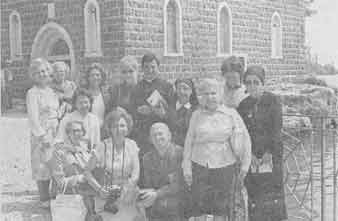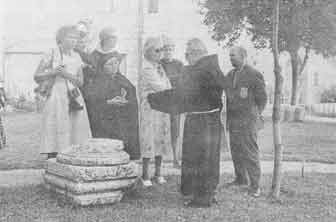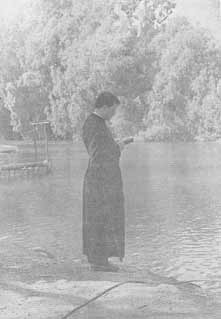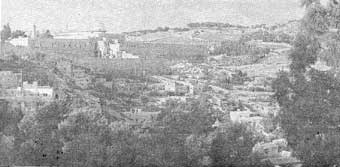An Unforgettable Easter in the Holy Land
by Phyllis Graham
WHAT HAPPENED to us on Easter Sunday during the recent Angelus Pilgrimage to the Holy Land could only happen during these rancorous times. And then, only to a band of faithful Catholic pilgrims led by a faithful Catholic priest. The episode may or may not be a foreboding of worse things to come, but it is at least worth the telling.
 |
The 1981 Angelus Holy Land Pilgrimage group at St. Peter's Church by the Sea of Galilee, where Jesus told Peter, "Feed my sheep ..."
We had already visited, and would not soon forget, the little town of Bethlehem—yes, it is still a little town, Nazareth, Capharnaum where Our Lord spent most of His three years teaching, preaching and healing, and the quiet boat-ride we took early one misty morning on the Sea of Galilee. (We learned that this peaceful body of water is a treacherous 150 feet deep, making it simpler to understand Peter's sudden panic immediately following his brave act of obedience when Jesus commanded him to walk toward Him on the water.)
 |
At Nazareth, the group visited the Church of the Annunciation where the Angel Gabriel appeared to the Blessed Virgin. Members of the pilgrimage received a comprehensive and informative tour of the Basilica grounds and recent excavations by the Franciscan custodian, a friend of one of the group members.
We had, soon after crossing the heavily guarded Jordanian-Israeli border and submitting to no less than eight suspenseful inspections of our passports, enjoyed Holy Mass in the peaceful Church of the Good Shepherd in Jericho, where a rotund, jovial Franciscan had greeted us with cheerful hospitality and enthusiastically prepared the altar for Father Babinet. Afterwards, the kindly monk had augured us a good trip with copious smiles and handsful of candy. It had been a reassuring welcome for us "traditionalists," for whom persecution often comes with surprising force from the most unexpected quarters. We were further encouraged on a subsequent day when Father Babinet was able to offer Mass on the gorgeous high altar of the Carmelite Monastery of Stella Maris, a beautiful church perched high atop Mont Carmel's promontory, overlooking the Mediterranean Sea. (Under that high altar is the crypt or cave where the prophet Elijah dwelled while taking refuge from Ahab.)
This was a pilgrimage, not a tour, and we were fortunate enough to be reminded of this every now and again by our leader, Father Regis Babinet, who not only is an excellent Holy Land guide, but whose frequent recitation of the Rosary with us and appropriate readings to us from Sacred Scripture at the various holy places, made meditation amazingly easy and vivid, and greatly enhanced our appreciation of what we saw. That, together with the natural beauty of the land, was making this trip an unforgettable one.
The hilly countryside of the Holy Land offers breathtaking views. At random, the eye falls on open fields of red, while and yellow wildflowers, pink oleander, blazing red hibiscus and tall, graceful palm trees. Here and there, rows of stately cypresses, like tall church spires, lift one's thoughts heavenward. Herds of chubby sheep and skinny goats graze lazily over pretty pastures, patiently tended by diligent bedoin shepherds who still dress and live, for the most part, as Abraham once did, in tents. Rolling hills are picturesquely terraced with low stone walls to prevent erosion and to contain the olive trees which for generations have been planted and cultivated there. (There are 16 million olive trees in Judea and Samaria alone, ranging in age from young saplings to gnarled ones thousands of years old, yielding an excellent oil which is used for cooking, soap, medicine and lamp-lighting.)
 |
Father Regis Babinet, who led the Pilgrimage, steals a few quiet moments from the group by the Jordan River to read his breviary. Father is Pastor of the Society of St. Pius X Jesus & Mary Chapel in El Paso, Texas. He travels an extensive Mass circuit throughout Southwestern America and into Mexico.
It is a land of happy children—multitudes of them, mostly Arab, robust and healthy, dark-complexioned with bright, innocent eyes and strong, pearly-white teeth, running, romping and chasing in the streets, but displaying very good manners and ready, polite smiles. The roads are dusty and the weather is sunny and very warm but made pleasurable by gentle desert breezes. The air is filled with the continual songs of birds and the occasional heady fragrance of orange blossoms. It is a beautiful land—no wonder Our Lord picked this place to live, out of all others!
A poignant part of the trip for us had been the Via Dolorosa in Jerusalem, a narrow, crowded and noisy, stone-paved street flanked by unending rows of open shops and stacked merchants' wares, along which the Son of God wearily dragged His heavy Cross. The look of that street is fairly much the same now as it was then, there are the same crowds, the same sounds, with everyone going about his business as probably many continued to do on that Friday, as if nothing really important was happening. The Stations are marked and one may visit some of the churches which have been erected there.
The culminating point of the Way of the Cross, and indeed the highest point of our pilgrimage, had been the Church of the Holy Sepulchre, built over the sites of Calvary and the Tomb; monuments recalling the greatest events in history, where we could actually see and touch such awesome sanctuaries as the very rock where the Cross stood (the hole is there!), the Stone of Unction, on which Our Lord's lifeless Body was anointed before burial, and the marble slab on which He lay for three days. Our visit here defies description: the place has long since lost its simple pastoral look of Biblical times, much of the original rock of the Tomb has been cut away and a grandiose church with high vaulted ceiling is over it all. Myriads of oil lamps hang from the ceiling in the typical Eastern manner and the pungent smell of incense pervades everything. But it does not matter what is there now or how it looks: this is Calvary, the place where It happened, and the soul knows it. Here, Jesus makes you believe in Him, and forces you to love Him. Here, tears flow unabashedly as pilgrims from all parts of the world find themselves openly compassionating a Crucified Savior. I forget which saint it was who came here and was instantly converted. It is not surprising. Certainly one does not pray at Calvary and come away from it ever to be the same.
AND SO IT WAS that we found ourselves on Easter Sunday, each of us with his own recollections but all of us eagerly anticipating the hour of 3:00 p.m. Father had announced the wonderful news that he had a reservation to say Easter Sunday Mass at that hour in the beautiful Basilica of Gethsemane, also called the Church of the Agony which is erected on the lower slopes of the Mount of Olives in the garden spot where Jesus came with His disciples to pray and where centuries old olive trees still stand, bearing witness to the most cruel moments of Our Lord's mental sufferings; the bare rock of the Agony is exposed and venerated in its sanctuary. What a singular privilege! We were looking forward to it.
There was nothing to forewarn us of what was about to happen, except that the day had dawned overcast and gloomy and that when we arrived at the church a crowd had gathered because of some altercation between the Franciscan brother custodian of the church and a member of the British press who was refusing to accept the fact that the doors of the church were closed to the press that day.
Our small group was ushered into the almost empty church through the sacristy and Father Babinet prepared for Mass. As we entered the church, I was aghast to notice that the beautiful marble altar pictured in the tour books had been removed and a severely plain, wide table (!) erected in its place, directly upon the sacred rock. I can honestly remember nothing else about the interior of that church, so dwarfed was its magnificence by the monstrosity of that table. We knelt uneasily and apprehensively as Mass started. Father faced us at the table, which was the only thing he could do, and reverently began, Introibo ad altare Dei... It was at the Dominus vobiscum immediately after the Gloria that the sacrilege took place. The Franciscan brother, only then having become aware that a Tridentine Latin Mass was in progress, suddenly intruded the sanctuary and told Father to stop! Father paused incredulously but answered him emphatically that Mass could not be stopped. Father continued. In an instant the brother angrily lurched forward, snatched the chalice and hurried with it to the sacristy. We were stunned! One by one, slowly we rose to our feet, dumbfounded. Father stood still for what seemed like a long time. We asked him afterwards and he told us that what had gone through his mind at that moment was that this same thing had happened to Archbishop Lefebvre at the Church of St. Mary Major in Rome. But in that case, it was the missal which was taken away and since the Archbishop knew the Mass prayers by memory, he was able to continue. But without the chalice, it was impossible. Father resignedly closed his missal and sadly left the sanctuary. Sheepishly, we followed him into the sacristy. The brother was snarling vituperations at him in Italian. Father Babinet, calm and remarkably patient, gravely reminded him of the Canon Law which mandates that the Holy Sacrifice once begun, may not be stopped. But the Franciscan, rapt in his own fury, did not even seem to be listening. He continued to hurl invectives. Father folded his things and prepared to leave when the superior arrived accompanied by the police. It soon became apparent that the Franciscan priest was demanding Father Babinet's arrest.
What was happening seemed incredible. Of what crime was Father being accused? What terrible thing had he done? "He is an imposter," they shouted to the police. "He is not of our Faith! He is the same as a Jew! a Moslem! ..." The same awful thing which had taken place on this very spot 2,000 years ago to an innocent and gentle Christ was happening now—and again it was aimed at Him.
 |
The many hills surrounding Jerusalem offer panoramic views of the Old City which is enclosed by a heavy wall (upper left to center). On the upper right can be
seen the Mount of Olives where the Garden of Gethsemane is located.
It was difficult to understand such black hatred of the very Mass which had fostered the vocations of these surely once-holy men, and it was terrifying to watch the depiction on their contorted faces of all the ugly devastation of the Catholic Church and the brutality which constituted the New Faith. I could not help but pity these sons of Fr. Francis who had once so joyfully written into their holy rule for approval by the Holy Father:
We will have no arguments or quarrels, either among ourselves, or with others . . . we will wish God's peace to everyone everywhere . . . we will be Catholics and live and talk as Catholics . . . we will honor the high and low clergy, considering them our master and revering their ministry in the Lord.
What untold tragedies have the "changes" wrought?
IT WAS PLAIN to see that the Franciscans were determined to have Father arrested and that they would be satisfied with nothing less. Livid with rage, the Franciscans took him into an inner room together with the police officer and a third elderly brother, the sacristan, banged the door shut, separating us from Father. The sacristan remained behind and demanded loudly in Italian that we leave. I entreated him in his own language to allow us to go with our priest but he was beyond reason or mercy and he furiously started to physically shove us out. We could not abandon Father so we resisted, and we were now beginning to fear for Father's safety. We were at a loss to know what to do: should we call the Archbishop? the American Consul? This was a strife-ridden land—who was there who could or would help us? In the hustle and confusion, Maria Liano whispered to me, "Do you think we should pray the Rosary?" That was it! Blessed Mother would help! We both quickly pulled out our Rosaries, fell to our knees and started praying aloud, "In the name of the Father, and of the Son, and of the Holy Ghost, Amen. I believe in God, the Father Almighty..." The others quickly followed suit and the sacristan, faced with thirteen kneeling, praying pilgrims, gave up his rampage. He immediately quieted down and slowly walked over to a chair by a desk at the doorway and sat down. We continued the rhythmic cadence of the Holy Rosary, praying with slow deliberation and all the fervor our hearts could muster. I implored her to soften the hearts of these misguided religious and somehow I knew that she would. As we prayed, Mrs. McGuire noticed that the meekened sacristan looked pitiably despondent. She went over to him and whispered, "Oh, these are bad times, bad, bad times." The brother struck his breast and murmured "mea culpa! mea culpa!" He wiped his tearful eyes with his handkerchief and blew his nose as she returned to her knees to pray. I do not know if the Rosary can be prayed more imploringly that it was that day. By the fifth mystery, the door of the inner room opened and Father came out. The police officer ordered us to "Go, follow your leader, and leave." The Franciscans had tried to have Father arrested but had failed. What had happened? Had the police officer, unlike Pontius Pilate, refused to wash his hands of it? From Father we later learned that at one point in that inner room, he had been surprised by a sudden and inexplicable change in their hostile attitude. In Father's own words:
At first they were antagonistic. They were horrible to me. The police officer was perplexed as to what to do. He did not wish to displease the Franciscans. Suddenly they changed. I don't know why. I was surprised. For me, it was like a miracle.
As we drove to the Vatican Embassy where Father reported the incident, we wondered about the meaning of what had happened. Was God displeased that the Holy Sacrifice was to be offered on a novus ordo table? Certainly, if we had learned nothing else, we had learned the glaring contrast between the true spirit of the Novus Ordo—or the brutality and irreverence of it—and that of the true Faith: indeed, they were diametrically opposed—one could not possibly serve the one and still be part of the other. For myself, who had been raised by none but the gentle Franciscans, it was heartbreaking—a painful reaffirmation of the Satanic ugliness of the post-Vatican II "spirit of renewal." We did not speak much about it as we boarded our bus and wanted only to remember the tremendous intercessory power of Blessed Mother and her Rosary.
Finally, we had our Easter Mass at the church of Fr. Babinet's friend, Patriarch Khadarevian, the Bishop of the Armenian Catholic Church of Jerusalem and Patriarch of all dioceses of the Armenian Catholic Church. He greeted us warmly with smiles and embraces, assuring us, "You are home, welcome!" His church is that of the Fourth Station of the Way of the Cross, where Our Lord meets His Sorrowful Mother. One hour before, we had not known that we would be here for Mass, yet it had been to our Sorrowful Mother that we had turned with confidence for assistance. It was all too much!
Our Easter Sunday Mass was a glorious one; a Latin Tridentine Mass, not only undoubtfully valid and undoubtfully reverent, but offered on an Altar undoubtfully sacred and pleasing to Almighty God, reminding me of the writings of a pious Jesuit, who reflected that because the Precious Blood is continually offered upon our Altars "Our churches surpass in sacredness the grotto of Bethlehem, the House of Nazareth, or even Calvary's Mount." The tall, bearded, handsome Patriarch, distinctive in his snowy white cassock, served Mass for Father Babinet and his rich full voice rose above ours as we sang our Easter hymn:
O filii et filiae,
Rex caelestis, Rex gloriae,
Morte Surrexit hodie,
Alleluia, Alleluia, ALLELUIA!
